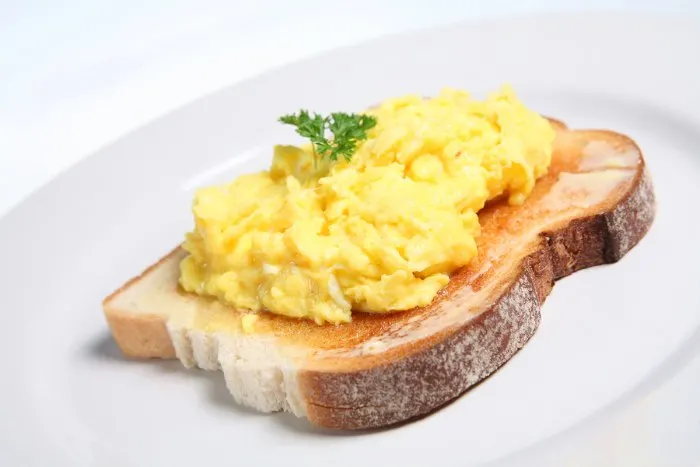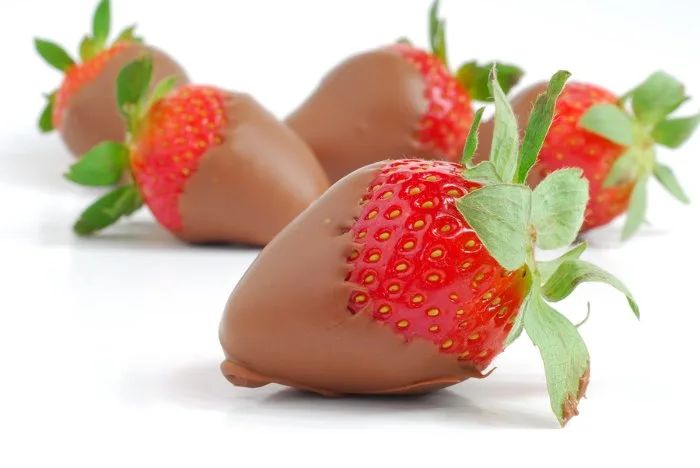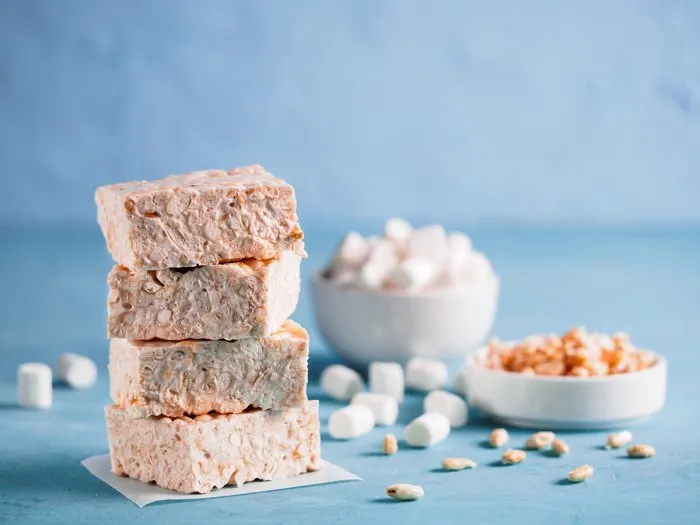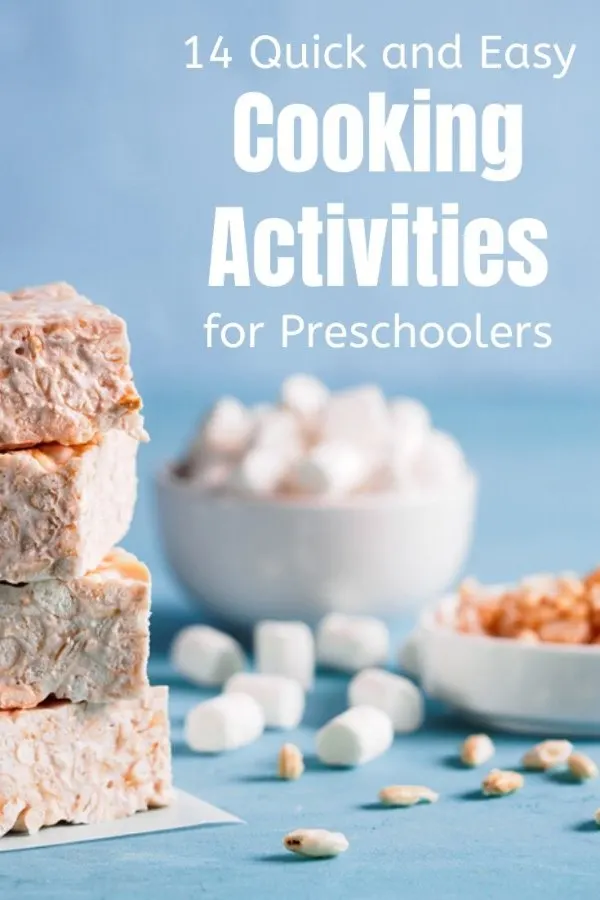Searching for some fun baking and cooking activities for preschoolers? Try these 14 simple recipes and ideas at home and get your kids engaged in some learning while cooking. Many are also great ideas for the classroom.
What Preschoolers Learn from Cooking Activities
Cooking with kids is an excellent educational activity and can be extremely fun and bonding. You may not even realize how many concepts and skills they will pick up as cooking is a hands-on activity that engages all the senses.
Here are just a few of the skills simple cooking activities will build:
1. Language and Vocabulary
When baking and cooking, children are building a vocabulary of food and cooking-related terms like:
- the names of ingredients
- the names of cooking processes – frying, baking, dipping, spreading
- mathematical language – measurements (half a cup, ml) and shape (flat, balls, cubes)
They are also learning to interpret recipes (even if you have to read the recipe out loud to preschoolers) and follow instructions.
Build your children’s language by talking through the steps as you do them:
- Roll your dough into small balls and place them in a row on the baking sheet.
- How is the consistency of your dough? Is it too runny? Should we add some more flour to make it less watery?
2. Fine Motor Coordination
Fine motor coordination is about strengthening the small muscles of the body, mainly the fingers. Children with good fine motor skills are able to control a pencil and write with control later on.
What better way to develop this skill than by preparing food using different utensils and materials.
Here are some kinds of movements and actions that will build fine motor control:
- Slicing
- Cutting
- Rolling
- Moulding
- Pressing
- Holding
- Mixing
- Stirring
- Spreading
3. Mathematical Skills
Cooking is the perfect way to teach maths concepts such as volume and capacity, measurement, shape and number concepts.
When children learn about capacity in a textbook at school, for example, it is often meaningless to them as they cannot really conceptualise the difference between 5ml and 5 litres. It is only really through real-world, hands-on activities that children can internalise these concepts.
If a child measures 1 teaspoon of baking powder or carries a 5-litre bottle of water, that is a real learning experience.
Cut fruit into cubes, use cookie cutters and make mini pizzas to learn about shapes.
A child may have memorised the numbers up to 10 but have they developed one-to-one correspondence? Get them to pass you one potato for each member of the family or count 5 pieces of fruit for each skewer.
Learn mathematical language while baking by using terms such as half a cup, less, more, full, etc.
Cooking (or baking) is one of the best ways to build early maths skills.
4. Problem Solving
Is the dough too thick or runny? Are you missing an ingredient that can be substituted? Are the fruit pieces too small to put on the skewers? Is the food burning?
Cooking involves continuously solving problems. Before it becomes time to solve lots of complicated mathematical problem-solving stories at school, set the foundation by giving your kids opportunities to solve real problems. This will translate into being better able to visualise and solve written problems later.
5. Social Skills
Cooking together with your child, or a group of children, is a great opportunity for them to practise social skills.
They will need to share tools, work together, help each other, consider others’ opinions, discuss each other’s roles in the process, etc.
Cooking is a wonderfully social and bonding activity.
Read about more benefits of cooking in early childhood.
14 Simple Cooking Activities for Preschoolers
This website is all about the simplest and easiest activities to get the most benefits for your kids. Follow these basic recipes that are also quick to follow.
Give your children as much control of the process as possible and don’t worry too much about making perfectly shaped cookies or getting the recipe just right.
Focus on the process, not the product.
You can read the ingredients and recipes with your children straight off your phone or another device.
Bon appetit!
1. Scrambled Eggs
It may seem daunting to let your children fry something on their own, but at long as you have a strict rule about only using the stove when they are with a parent, there’s no reason they can’t learn this skill early.

Teach your kids to break eggs carefully, beat it with a fork, mix the eggs and watch the consistency change as it heats up on the stove.
Ask them to tell you when they think the eggs are ready, and why, instead of telling them.
Make some toast and you have a quick, tasty breakfast.
Ingredients:
- Eggs
- Milk
- Salt and pepper
Method:
- Break an egg into a small bowl.
- Beat the egg with a fork.
- Add a little milk.
- Heat a dab of butter in a frying pan.
- Heat the egg in the pan, mixing continuously until it is scrambled and cooked through.
- Add salt and pepper to taste.
2. Peanut Butter Cookies
Making these peanut butter cookies will provide a textural and sensory experience as children have to mould the mixture into small balls.
This will also develop their fine motor control as they must learn to manipulate the mixture in their hands and learn the technique of rolling.
Ingredients:
- 1 Cup peanut butter
- 1 Cup brown sugar
- 1 Egg
Method:
- Combine the eggs, peanut butter and brown sugar in a bowl.
- Roll the mixture into balls.
- Place on a baking sheet.
- Press a fork over the balls to create a pattern.
- Bake at 180⁰C/ 350⁰F for 6-8 minutes.
3. Alphabet Dough
Expose your kids to the letters of the alphabet by making your own playdough and moulding it into individual letters.
Show a letter – preferably a large plastic or foam letter – and ask them to mould the letter out of the dough. A child who moulds and touches a letter shape is more likely to remember the formation of the letter than by writing it on paper. This is real hands-on learning.
The best letters to start with are the letters of their name.
Get kids to measure out the cups of flour, salt and water and make the playdough themselves. Mixing the dough is good for strengthening the finger muscles too.
Making playdough is a good early science activity as you can learn about the properties of water and substances like flour. Encourage your children to add water if the mixture is too dry or more flour if it is too sticky.
Ingredients:
- 2 Cups flour
- 1 Cup salt
- 1 Cup water
Method:
- Mix the flour and salt in a bowl.
- Slowly add in the water and mix until the mixture has the consistency of playdough.
4. Dipped Strawberries
Dipped strawberries are perfect for a mostly healthy dessert, with a touch of delicious chocolate.

Ingredients:
- Strawberries
- Chocolate chips
Method:
- Melt the chocolate chips in a bowl in the microwave (stir every 15 seconds until fully melted).
- Dip the strawberries until they are covered halfway in chocolate.
- Lay them on a baking sheet to dry.
5. Frost Cookies
This one is a real treat that your kids will enjoy making.
Learning to spread is not an easy skill for a young child to learn so getting the icing onto these cookies, as well as placing the little sweets on top, will be good fine motor skills practice.
Ingredients:
- Cookies or biscuits
- Frosting
- Food dye
Method:
- Use freshly prepared or store-bought cookies or biscuits.
- Mix some food dye in the frosting to get the desired colour.
- Spread the frosting on the cookies with a knife or spatula.
- Press smarties or other small sweets into the icing.
6. Fruit Salad
A simple activity such as making fruit salad can be such a great way to practise cutting and chopping while supervised.
Ask children to cut the fruits that will easily be sliced with a relatively blunt knife (you don’t want to be chopping fingers off too) and supervise throughout the process.
Cut the fruits into very small pieces. The smaller the pieces, the more flavour the fruit salad will have when all the different fruits are mixed together.
This can get tiring for little fingers so help if needed.
Ingredients:
- Fruits such as strawberries, grapes, oranges, bananas, mandarin oranges, pineapples, apples, etc.
Method:
- Cut the fruits into small cubes.
- Mix them all together in a bowl.
7. Rice Krispie Squares
Rice Krispie squares are another favourite with the kids.

Use this as a mini science lesson and teach your kids how heat changes the properties of the butter and the marshmallows. Note what happens to them when they cool down and harden again.
Ingredients:
- 6 Cups Rice Krispies.
- 3 Tablespoons butter.
- 1 Packet of Marshmallows.
Method:
- Melt the butter in a saucepan.
- Add the marshmallows and heat until completely melted.
- Add the Rice Krispies and stir until evenly coated.
- Pour the mixture into a pan.
- Cut into squares and leave to cool.
8. Pancakes
Although it is not difficult to make pancakes from scratch, learning to read the instructions on a packet is a good life skill and will teach children about measurement.
Buy a ready pancake mix and read the ingredients one at a time as your children gather them. Then, read the instructions one step at a time, pausing after each to let kids follow them, and see how many of the steps they can do independently.
Show children how the format of a recipe works – how the ingredients are listed first, followed by the method.
Ingredients:
- 2 Cups pancake mix
- 1 Cup milk
- 2 Eggs
- Cinnamon
- Sugar or maple syrup
Method:
- Mix all the ingredients (some mixtures may vary).
- Pour a soup spoon of batter into a pan and heat until golden brown.
- Flip over to heat the other side.
- Serve with cinnamon and sugar/maple syrup.
9. Cookie in a Mug
Want a recipe for a quick cookie when you don’t have time to bake a whole batch?
Try this easy-peasy cookie in a mug.
Ingredients:
- 1 Tablespoon melted butter
- 1 Tablespoon brown sugar
- 1 Tablespoon white sugar
- 1 Egg yolk
- ¼ cup flour
- Pinch of salt
- Chocolate chips
Method:
- Mix the melted butter, sugar, salt and egg in the mug.
- Add the flour and chocolate chips and mix well.
- Microwave for 1 minute (or slightly longer until cooked).
10. Mini Pizzas
Your kids will love making mini pizzas and will get to practise new skills like rolling, spreading and grating.

Form circles with the pizzas or make other shapes like squares and hearts to teach shape recognition.
Buying ready-mixed pizza dough will make this a quick recipe to follow.
Ingredients:
- Pizza dough
- Grated cheese
- Tomato sauce
- Toppings – (olives, spinach, mushrooms, pineapple, meats, etc)
Method:
- Roll out the pizza dough using a rolling pin.
- Form mini circle-shaped or heart-shaped pizzas.
- Spread tomato sauce onto each pizza.
- Sprinkle cheese and other toppings of choice on top.
- Bake as per the instructions on the dough.
11. Salsa
This simple salsa recipe is another great fine motor activity as the ingredients are chopped finely. With practice, children will develop good control when holding and using a (blunt) knife.
Ingredients:
- Tomatoes
- Onions
- Lemon
- Cilantro
- Salt
Method:
- Chop tomatoes and onions into small cubes.
- Finely chop the cilantro.
- Mix them all together in a bowl.
- Squeeze some lemon juice onto it and add salt to taste.
12. Sandwiches or Wraps
A simple, everyday lunch like a sandwich may be easier to quickly whip up for your kids but is a perfect opportunity to practise skills and gain some independence.
Children love feeling they have accomplished and made something on their own. So on some days, invite your children to make their own sandwiches or tortillas.
Ingredients:
- Bread or tortillas
- Meat
- Condiments and sauces (mustard, mayo, butter, etc)
- Toppings (lettuce, cheese, pickles, etc)
Method:
- Spread the condiment or sauce evenly onto the bread or tortilla.
- Add toppings/meat.
- Cut into halves or quarters.
13. Fruit Skewers
Fruit skewers are a great way to teach patterning and require a lot of fine motor control.

For younger children, get them to follow a simple pattern, such as grape, strawberry, grape, strawberry. Older children can follow more complex patterns such as raspberry, blackberry, strawberry, blueberry, and repeat.
Next time you have guests, make these as a refreshing snack.
Ingredients:
- Fruits that are easy to place on a skewer – grapes, berries, melons, etc.
Method:
- Wash the fruits.
- Cut them into manageable-sized pieces.
- Place them onto the skewers according to the pattern or order of fruits.
- Lay them onto a tray to serve.
14. Popsicles
To make fruit juice popsicles you will need popsicle containers that come with their own stick, or you can get creative and use another container with a wooden stick placed into the open end.
Nothing is more refreshing on a hot day than a frozen popsicle stick.
Learning to pour is also an important life skill for young children. It may be messy at first but the sooner this skill is learnt, the fewer spills you will deal with in your house.
To make a healthier version, dilute the fruit juice with water. You could even juice some veggies in a juice extractor and add some juiced pear or apple for sweetness.
Ingredients:
- One flavour of fruit juice (apple, pineapple, grape, orange, etc)
Method:
- Pour the juice into the container and close or place a wooden stick in the open end, standing upright.
- Place into the freezer until frozen and ready to eat.
I hope you’ve found some ideas for cooking and baking with your kids. If you take any message from this article, let it be that anything your children can do for themselves or can learn to do – in moderation – is an opportunity they should have.
Here are some fun food songs to teach your kids while you cook together.

